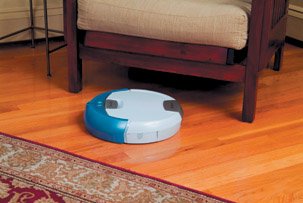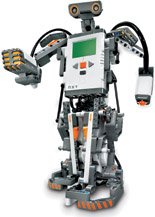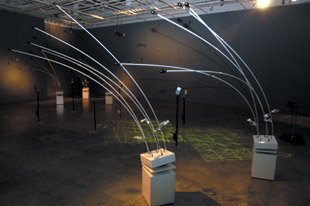| Robots are no longer the science-fiction machines of yore, nor are they used only to create cars in factories. Robotsbroadly defined as programmable machines that can perform specific physical tasksare among us, likely for good. A robot, however, is more than just an object. It is both a product and a service. The South Korean Ministry of Information and Communication predicts that by 2020, every household in South Korea will have a robot. While other countries have focused on robots for military or industrial use, South Korea is developing networked robots for services like babysitting, cleaning, and security. As early as 2007, these robots are scheduled to be on the market. But it's not only South Korea that will see an influx of robots; robots are being designed and built all over the globe: as floor cleaners (Figure 9.2), toys (Figure 9.3), musical instruments (Figure 9.4), and more. Because of the complex issues surrounding robots, from the emotional to the technical, interaction designers need to become more involved in their creation and use. Figure 9.2. iRobot's Scooba is a floor-washing robot that can prep, wash, scrub, and dry hard floors, all at the touch of a button. 
Figure 9.3. Lego Mindstorms allow children and hobbyists to create sophisticated robots easily. 
Figure 9.4. ForestBot is a robotic installation by the music/technology group League of Electronic Musical Urban Robots (LEMUR). ForestBot is a collection of 25 ten-foot stalks that each have an egg-shaped rattle mounted on the free end. 
courtesy of LEMUR
Interaction designers need to be aware of two factors when designing robots: autonomy and social interaction. Autonomy is the robot's ability to act on the user's behalf. Robots like those of Lego Mindstorms have very little autonomy, but some "robots," such as pacemakers and artificial hearts, have full autonomytheir human users don't have to tell them to work. Similarly, there are robots, like the toy Furby, that engage in little reciprocal interaction, and others, like Carnegie Mellon's Valerie, the robot receptionist (Figure 9.5), designed specifically to interact with humans. Figure 9.5. Carnegie Mellon's roboreceptionist gives directions, answers the phone, and even gossips about her "life." 
Robot designer and professor Jodi Forlizzi has outlined three main design issues with robots: Form. Does the robot have a humanlike appearance? How big is it? What are its physical characteristics such as size, shape, scale, and the materials it is made of? Function. How does the robot communicate and express itself? Does it use sound, motion, gesture, light, color, or scent? Manner of behavior. How does the robot behave and in what situations? How does it go about its activities and how does it interact with humans? How social is it?
Carl DiSalvo on Designing for Robots 
courtesy of L. Arthi Krishnaswami Carl DiSalvo is currently a post-doctoral fellow with joint appointments in the Center for the Arts in Society and the Studio for Creative Inquiry at Carnegie Mellon University. Previously, Carl worked as a designer for MetaDesign and as a consultant for the Walker Art Center's New Media Initiatives. In 2006, he received a Ph.D. in Design from Carnegie Mellon University. As a graduate student, he worked as a design research associate on the Project on People and Robots at the Human-Computer Interaction Institute. Briefly describe the realm of robots. What type of robots are being made or planned? We can make some distinctions among robots, but none of them are mutually exclusive. A robot could, and often does, fall into two or more categories. For example, there are social robots, service robots, and field robots. Many of these distinctions actually relate to the research question at hand more than to a kind of consumer product. This of course reflects the fact that outside of a few domains and a few choice examples, robots still are primarily research endeavors. The most common domains for contemporary robotic products are military or industrial settings. Robots are also beginning to be used in medicine and scientific exploration. And of course toys. Robots for the home consumer, such as the Roomba, are still uncommon. For example, there are a handful of vacuum and lawn-mowing robots, but other than that, except for toys, there aren't really robots, as we commonly think of them, in the home. What type of design work is being done with robots now? All kinds. This is what makes robotics so exciting. The challenges and opportunities of robotics sweep across every field of design. Perhaps the most obvious is the work in industrial design in creating the visual form of the robot. The industrial design of a robot is an example of styling visual form with significant impact on interaction. In fact, it's difficult to separate industrial design from interaction design in robots. Because of the newness of robotics and the public's unfamiliarity with robots, the visual form of the robot often takes a precedence in shaping our expectations of the robot and how we interact with the product. In addition to designing the visual form of the robot, there is a lot of interface design involved with robots: interfaces for tele-operation as well as interfaces for direct interaction. These interfaces might be screen based, physical, voice, or some combination of the three. Because we have yet to arrive at any standards for, or even common experiences of, interacting with a robot interface, interaction design for robotics is open to broad inquiry and invention. How is Designing for Robots Different From Designing Other Products? Robots are hyperboles of the products contemporary designers are challenged with. That is, they are an exaggeration of the contemporary products because robots are "everything all at once": complex embodied technological artifacts that require significant design knowledge of industrial, communication, interaction, and service design; potent cultural icons; and, too, the most mundane of gadgets. All of the diverse elements of a product are brought together and amplified in a robot. This presents a nearly unique challenge and opportunity. Designing robots requires a level of synthesis not often encountered in other products. What will be the role of interaction designers in this field in the future? In many ways, robots are still fictional entities, at least when it comes to common consumer products. Interaction designers have the opportunity to invent what these new products of the future might or should be like. This comes along with significant responsibility to shape these products in ways that are not merely seductive but appropriate. One of the most pressing needs concerning the design of robots, concerning design in general, is to consider how these nascent technologies become products, and in the process to take up the opportunity to critically engage these technologies, rather than simply striving forward with unreflective novelty. |
|




